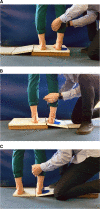Supination resistance variations in foot and ankle musculoskeletal disorders: implications for diagnosis and customised interventions with wedged insoles
- PMID: 38129924
- PMCID: PMC10740238
- DOI: 10.1186/s13047-023-00681-5
Supination resistance variations in foot and ankle musculoskeletal disorders: implications for diagnosis and customised interventions with wedged insoles
Abstract
Background: Supination resistance is a clinical outcome that estimates the amount of external force required to supinate the foot. A greater supination resistance may indicate greater loads on structures responsible for generating internal supination moments across the subtalar joint during static and dynamic tasks. As such, greater supination resistance may be an expected finding in medial foot and ankle musculoskeletal disorders, such as plantar fasciopathy (PF) and posterior tibial tendon dysfunction (PTTD), whereas reduced supination resistance may be present in lateral ankle disorders, such as chronic ankle instability (CAI). However, no studies have yet investigated the changes in supination resistance across these foot and ankle musculoskeletal disorders. This study aimed to quantify supination resistance in individuals with PF, PTTD and CAI compared to healthy controls. Additionally, this study aimed to explore the changes in supination resistance following the simulation of varus and valgus wedges, which are commonly used interventions for these disorders.
Methods: Fourteen participants with PF, fourteen with PTTD, fourteen with CAI and fourteen healthy controls were recruited. Supination resistance was quantified on a level surface and on a 10-degree inclined surface with varus and valgus positions.
Results: Supination resistance was lower for the injured foot for CAI (p < 0.001) and greater for PTTD (p < 0.001) compared to the healthy foot. There was no significant between-foot difference observed for PF (p = 0.275) and controls (p = 0.970). In the injured foot, CAI exhibited lower supination resistance compared to controls (p < 0.001), PF (p = 0.012) and PTTD (p = 0.014). Regardless of the groups, supination resistance increased when tested on a surface with valgus inclination (p < 0.001) and decreased when tested on a surface with varus inclination (p < 0.001).
Conclusions: Varus and valgus inclinations to the surface were effective in modifying supination resistance in PTTD and CAI, respectively. Supination resistance seemed unchanged in PF, and thus inclining the standing surface leads to greater between-feet asymmetries. This study also highlights the potential of wedged insoles as a mean to customise treatments and modify tissue stresses in these disorders. The findings contribute to the understanding of foot and ankle biomechanics and may aid in the development of more effective management and rehabilitation strategies.
Keywords: Ankle; Foot; Musculoskeletal diseases; Physical examination, Biomechanical phenomena.
© 2023. The Author(s).
Conflict of interest statement
All authors declare that there are no personal or commercial relationships related to this work that would lead to a conflict of interest.
Figures



References
MeSH terms
Grants and funding
LinkOut - more resources
Full Text Sources
Research Materials

